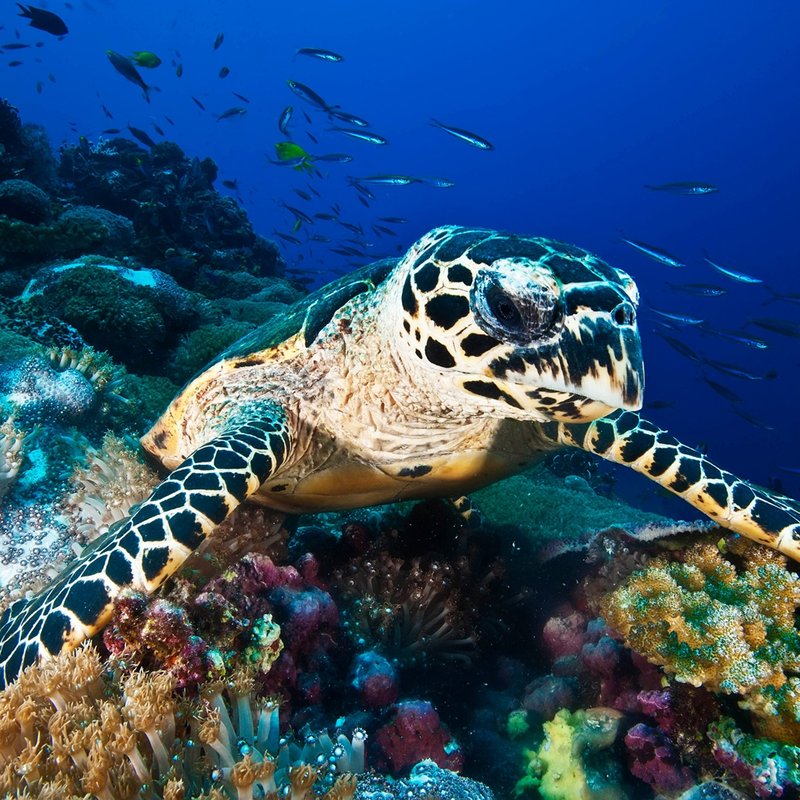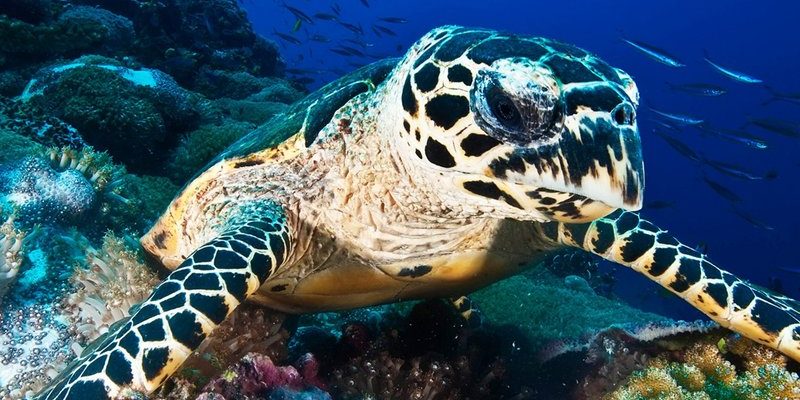
Let’s dive a little deeper, shall we? These turtles have evolved over millions of years to excel in their marine habitats. From their unique shells to specialized feeding habits, each adaptation plays a vital role in their survival. So, grab your snorkel as we explore how the hawksbill turtle thrives in its underwater environment.
Streamlined Shell Design
One of the first things you’ll notice about the hawksbill turtle is its striking, patterned shell. Unlike other turtles with more rounded shells, the hawksbill has a sleek and elongated form that helps it glide through water with ease. This streamlined shape reduces drag, allowing it to swim efficiently even in strong currents.
The shell is not just for looks; it’s crucial for protection as well. Hawksbill turtles have a hard, bony shell that shields them from predators like sharks and large fish. When threatened, they can tuck their heads and limbs inside their shell, creating a fortress of sorts. This adaptation makes them feel safe while they navigate through coral reefs or dodge would-be attackers.
But here’s the thing: the beauty of their shell comes with a price. Its unique structure makes it highly sought after for decorative items. Conservation efforts are critical to protect these turtles from poaching and ensure their survival in the wild.
Strong Flippers for Agile Swimming
When you watch a hawksbill turtle swim, it’s like seeing a dancer in the water! Their strong flippers are adapted for powerful swimming, helping them maneuver gracefully among coral reefs. Each flipper is more elongated compared to other turtles, which allows for more agility and speed.
These turtles often dive deep to find food or escape danger. They can hold their breath for up to 30 minutes while reaching depths of around 30 meters (about 100 feet). This ability to swim long distances with strong strokes is vital for a species that travels between feeding and nesting grounds, often covering large areas of ocean.
If you’ve ever tried swimming against a strong current, you know how challenging it can be! The hawksbill’s solid flippers make it easier for them to navigate through these challenging waters, ensuring they can find food and evade predators more effectively.
Specialized Jaw Structure
Have you ever wondered how hawksbill turtles eat? Their unique jaw structure plays a major role in their diet. Unlike other turtles that might munch on seaweed or grasses, hawksbills have a beak-like mouth that resembles a bird’s. This shape allows them to reach into crevices of coral reefs and extract sponges, their favorite snack.
Sponges are tough and fibrous, making them a bit of a challenge to eat. But the hawksbill has adapted to tackle this! Their beak can easily break through the tough outer layer of the sponges, giving them access to a nutritious meal. This specialized feeding adaptation not only provides them with food but also helps maintain the health of coral reefs by controlling sponge populations.
Moreover, the hawksbill turtle’s diet contributes to its role in the ecosystem. By keeping sponge populations in check, these turtles help promote the growth of corals and other marine life, ensuring a vibrant underwater environment.
Coloration and Camouflage
Color plays a significant role in survival for many species, and the hawksbill turtle is no exception. Their rich, patterned shells not only add beauty but also serve as effective camouflage. When cruising through the vibrant coral reefs, their colors help them blend in with the surroundings, making it harder for predators to spot them.
This natural disguise is particularly useful when they are resting or foraging for food. Imagine wearing a camouflage suit while hiking in the woods; you’d blend in with nature, making it easier to avoid detection. Hawksbill turtles do the same underwater. This adaptation is crucial, especially for younger turtles, which are more vulnerable to predators.
Additionally, their coloration can play a role in temperature regulation. Darker shells absorb more sunlight, which can help them stay warm in cooler waters. It’s a clever way nature has designed them to thrive in varying marine climates.
Resilience to Marine Pollutants
In today’s world, pollution is a huge problem for marine life, but hawksbill turtles have shown an impressive level of resilience. Their bodies are adapted to handle certain toxins found in the ocean, especially in areas where human activity is rampant.
Unfortunately, this doesn’t mean they’re immune to the effects of pollution. Plastics and chemicals can still pose serious threats to their health. However, their ability to process toxins gives hawksbills a better chance to survive in polluted waters compared to other species. It’s like having a built-in filter that helps them navigate their often toxic environments.
That said, it’s essential for us to do our part in reducing ocean pollution. By keeping our oceans clean, we can ensure that these amazing creatures continue to thrive for generations to come.
Long Lifespan and Reproductive Strategies
Hawksbill turtles also have a longer lifespan than many other marine species, with some living up to 50 years or more. This longevity gives them more opportunities to reproduce over time. They generally reach maturity at around 20 to 30 years, which means they can contribute to their population over several breeding seasons.
During nesting season, female hawksbills travel to sandy beaches to lay eggs, often returning to the same spot where they were born. This phenomenon, known as natal homing, ensures that their offspring have the best chance of survival in a familiar environment.
However, the odds are still stacked against them. On average, a female hawksbill lays about 100 eggs, but only a small fraction of hatchlings will survive to adulthood due to various threats. By understanding their reproductive strategies, we can better protect nesting sites and take steps to ensure the survival of this beautiful species.
Conservation Efforts for Hawksbill Turtles
With all their incredible adaptations, it’s hard to imagine that hawksbill turtles are currently endangered. Their beautiful shells, while stunning, make them targets for poaching. Conservation organizations worldwide are working tirelessly to protect these turtles and their habitats.
Efforts include creating protected areas, enforcing fishing regulations, and reducing marine pollution. Programs aimed at educating the public about the importance of hawksbills in the ecosystem also play a crucial role. By raising awareness, we can encourage more people to care about marine conservation.
Moreover, scientists are conducting research to understand better the behaviors and needs of hawksbill turtles. If you ever get a chance to support conservation initiatives, know that you’re helping to ensure these magnificent creatures continue to thrive in our oceans.
In conclusion, the hawksbill turtle is a true marvel of nature. From its streamlined shell to its unique feeding habits, every adaptation helps this species thrive underwater. It’s a reminder of the incredible resilience of life and the importance of protecting our natural world. So, the next time you think about these turtles, remember the extraordinary ways they survive against the odds. Every little effort counts in ensuring they remain a part of our oceans for years to come.

